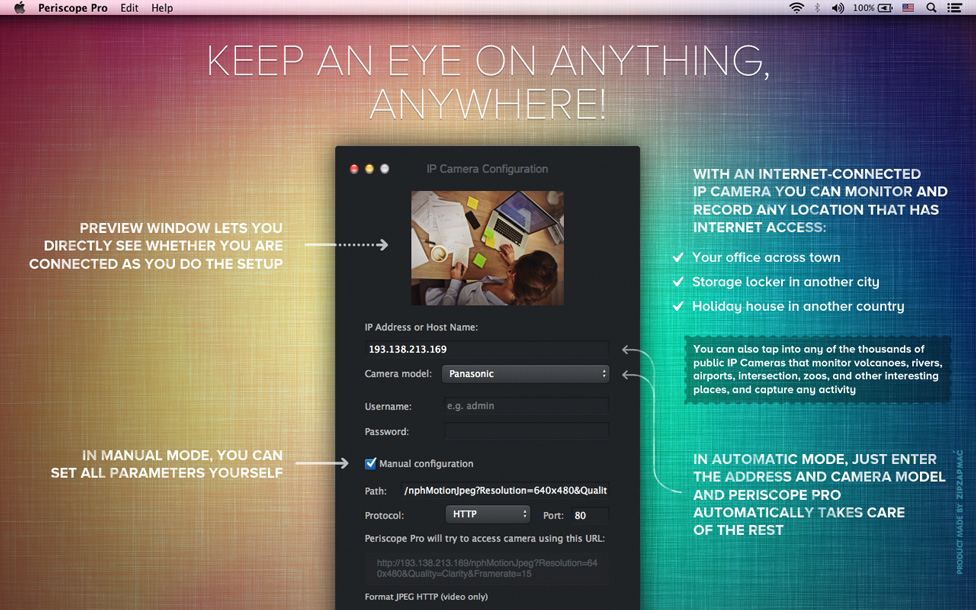Multi-camera phones are the norm now, but the modules they use have a traditional design, one optimized for size. This limits the focal length – which, true to its name, is a measure of the distance from the lens to the sensor – meaning that telephoto cams rarely go above 2x zoom (and we're yet to see one go above 3x).
Periscope Pro 3 1 12

What's New in Version 3.1.1 +20 IP Camera Vendors +950 IP Camera Models Sound from IP Cameras for live preview and recording Support for H.264 IP Cameras H.264 movie encoding Support for RTSP, RTSP-UDP, RTSP-over-HTTP cameras Improved motion detection and audio detection algorithms Support for iOS Periscope Pro HD Camera (will be available soon). Periscope Pro was added by TVDN in Sep 2015 and the latest update was made in Aug 2017. The list of alternatives was updated Sep 2018. It's possible to update the information on Periscope Pro or report it as discontinued, duplicated or spam.
Lossless photo squeezer 1 70 – reduce image size. A new breed of telephoto cameras has emerged at this year's MWC (we've seen prototypes earlier, but no mass market products). Yes, we're talking about the periscope type cameras, which are called that because light is reflected 90°.
This guides light along the width of the phone, allowing for long focal lengths without making the phone too thick. Better still, the prism that reflects the light can be used for optical image stabilization (vital for long focal lengths where even small hand shake is multiplied).
The upcoming periscope camera modules we've seen from a couple of makers have 160mm focal length. Sometimes they advertise that as '10x zoom', measuring it against a 16mm ultra-wide angle camera. A different rating will compare it to wide-angle main camera (typically in the mid-20s millimeters) and dub it 5x. Edgeview 2 77379.
For comparison, the tele camera on the Huawei Mate 20 Pro is 80mm, giving it 3x optical zoom over the 27mm main camera. So, if the P30 Pro keeps the main camera at 27mm and it uses a 160mm periscope telephoto lens, that will be 6x zoom.
In case you're new to this, 'millimeters' are an absolute measurement of focal distance* – a higher number means a zoomed-in view, a low number is a wider view. The 'x' ratings are relative, just a ratio of max mm / min mm. As an example, 80mm / 27mm = 3x.
* the numbers are typically given in '35mm equivalent' to make comparisons easy. This refers to DSLR cameras with 35mm sensors. You can see what field of view each focal length gives you in tables such as this one.
Periscope cameras are not a new concept, you may have seen them in sporty, rugged point-and-shoot cameras. They keep the optics inside (rather than protruding forward), making the system more durable. They do allow smooth zoom instead of being locked to a specific focal length like the first generation smartphone modules are.
Rugged point-and-shoot cameras with periscope optics
If they are more durable, why don't all point-and-shoot cameras use this design? It's trickier to get the same quality of the the optics, so the design is not without tradeoffs.
Are you excited about periscope zoom cameras? They will be featured on phones like the Huawei P30 Pro, Oppo Reno and others. You can see leaked camera samples from them here and here, respectively, also our test of the Oppo prototype (a Reno in disguise).
Reader comments
- Anonymous
- 3J9
Everyone needs ti focus on zoom and lowlight like Huawei
- gDs
I suggest that you read that too. Because optical zoom is not some magical tech without drawbacks to image quality, despite whatever b/s phone marketing departments try to push.
- Anonymous
- ajb
Monstrum 1 0 – traditional survival & horror game. how small a sensor can be to be placed in a phone a few millimeters thick and still deliver a good photo? It's a nice concept, but it might come with smudgy photos to suppress the noise, and would be priced a bit higher. So maybe we'll see some d..
